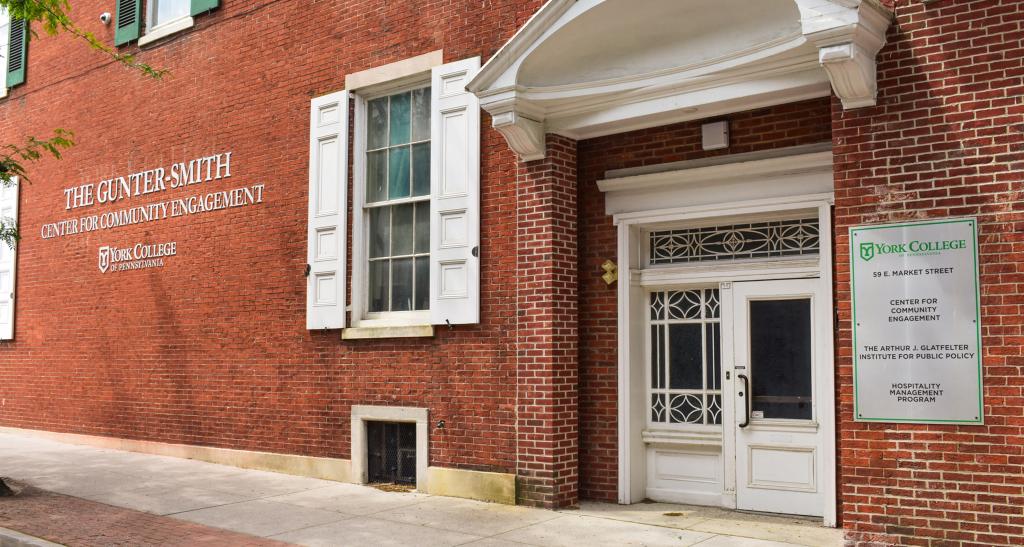A place to convene
The Gunter-Smith Center for Community Engagement is located in a beautifully restored, historic building at 59 East Market Street in Downtown York. Formerly home to the Lafayette Club, the building now serves as a center for fostering connections between York College of Pennsylvania and the community at large. This downtown location is home to the main offices of the Center for Community Engagement Division and the Arthur J. Glatfelter Institute for Public Policy. In addition, it provides a variety of spaces for York College classes, community meetings, private events, and more.
Visitor Information
Contact
Location
The Gunter-Smith Center for Community Engagement
59 E. Market Street
York, PA 17401
Visitor Hours
Monday–Friday | 9 a.m.–4 p.m.
Parking
Garage parking is available nearby at 41 E. Market St. and street parking is available on N. Duke St. Visit the York City Parking Bureau website for detailed information.
From the York College Main Campus
Downtown York is a short bus ride from stops just a block away from the College's main campus via Rabbit Transit Route 8S and Route 9S, or a 1-mile walk from north campus via the scenic Heritage Rail Trail.
Event Rental Information
Fireplace Room
Aptly named for its functioning gas fireplace, the Fireplace Room is a wonderful space for a formal meeting, cocktail reception, or intimate dinner. This space comfortably seats up to 36 guests based on layout needs.
Mural Room
Showcasing murals depicting Colonial York City painted in the 1960s by artist Charles X. Carlson, the Mural Room sets the stage for mixing and mingling. Use this space in combination with the Community Room or Fireplace Room to stage your buffet, serve drinks from behind the bar, or as a separate gathering space for your guests. This space can accommodate up to 40 guests standing.
Community Room
Equipped with an HDMI-compatible projector, drop-down projection screen, and built-in speakers, the Community Room provides the multimedia necessary for your audiovisual needs. Cozy enough for groups of 20–30 and spacious enough for groups of 70–80.
North and South Parlor Rooms
Located on the first floor of the building near the main entrance, the parlor rooms provide a bright and comfortable setting for event check-in or a small cocktail reception. This space can accommodate up to 40 guests standing.
Arthur J. Glatfelter Institute for Public Policy Conference Room
This cozy space is perfect for staff meetings, focus groups, and other small business gatherings. Furnished with a long wood table and equipped with an HDMI-compatible television monitor, this room works well for groups of up to 10 people.
The Powder Mill Suites: The Rose Room
Equipped with TV monitors, dry erase boards, and desktop computers, This room is well-suited for classes and small meetings. It can accommodate up to 16-20 guests seated.
The Building’s Beginning
The building at 59 East Market Street was designed in the Classical Revival style and erected in 1839 to serve as a home for Philip Albright (P.A.) Small and his family. Following in the footsteps of his entrepreneurial father, P.A. Small became a community leader and one of the most successful merchants in York in the 19th century. Along with his brother Samuel, he co-owned P.A. & S. Small Co., which sold a variety of goods — including iron products and flour — and operated in York for 150 years. In 1863, during the Civil War, the Confederate army invaded York and Brigadier General John Gordon stopped at the front steps of the P.A. Small house to speak to the ladies who lived there. P.A. Small’s daughter Cassandra, who witnessed the invasion, wrote a detailed account of the harrowing event in a letter to her cousin.
Legacy of Social Clubs
In 1912, the Small house was acquired by the Lafayette Club, a social organization for gentlemen, that had been established in 1898. The Lafayette Club emerged from an earlier generation of social clubs formed in the mid-1800s. The York Club, established in 1858, was a small, members-only club for prominent men in the community. The York Club merged with the Lafayette Club around the turn of the 20th century, bringing traditions and regulations that helped to shape the club’s operations for years to come. A few years later, the Bachelor Club — originally established as the Cycle Club, in response to the increasing popularity of the bicycle as a mode of transportation — merged with the Lafayette Club, as well.
The First Renovation
After purchasing the building at 59 East Market Street, the Lafayette Club embarked upon substantial renovations to the building, including the construction of bowling alleys and a small tavern in the basement; lounging, reading, and billiard rooms on the first floor; a library, private dining room, and roof garden on the second floor; and a game room and private apartments on the third floor. In addition, they created a side entrance to the building from Duke Street and retrofitted the building with toilet rooms, kitchens, and dumbwaiters, telephone booths, and push buttons for calling servants. The members of the Lafayette Club celebrated the completion of the renovation on February 27, 1913, by hosting an elaborate party with food, floral decorations, and music, and showing off the new features and amenities to about 1,000 guests.
Exclusivity and an Evolving Society
The Lafayette Club had a history of exclusivity — its members consisted solely of white men for almost a century. In 1938, the club held its first “Ladies’ Night,” where wives and guests of members could take advantage of the building’s amenities. This event became a recurring tradition starting in 1949, but otherwise, access to the club was limited to its male members. In the 1990s, the club began to accept women and people of color as members, in an effort to diversify the organization. However, at the beginning of the 21st century, the facilities of the Lafayette Club were eclipsed by technological advancements. With widespread use of cell phones and computers, and an increased desire for public meeting spaces, the amenities offered by the Lafayette Club were no longer advantageous to the community. Therefore, the club was compelled to shut its doors in 2012.
The Second Renovation
The building was not vacant for long, however. After the Lafayette Club disbanded, philanthropist Louis J. Appell Jr. acquired the building and generously donated the property to York College in 2015 to be used for classes and community events. Thanks to Mr. Appell’s contribution, funding from York College, and additional support from foundation grants, the College was able to hire Murphy & Dittenhafer Architects to restore the historic elements of the building while updating it for modern use. One of the first spaces to be renovated was the basement, which was converted into a commercial-style kitchen lab for the York College Hospitality Management program. Murphy & Dittenhafer preserved many unique historic features throughout the building, such as wood trim and floors, marble fireplaces, stained glass, a wall mural of Colonial York (painted in the 1960s), and two phone booths under the grand staircase (now used as coat closets). They also improved the functionality and accessibility of the building by adding new heating, air-conditioning, and fire sprinkler systems; changing the main point of entry to the Duke Street entrance so that it would be at street level; and installing an elevator.
Connecting the College and the Community
The 59 East Market Street building is now home to the York College Center for Community Engagement (CCE) and serves as a hub for York College students and faculty as well as for members of the York community — just as Mr. Appell envisioned. The main floor of the building offers a variety of unique event spaces and regularly features work by local artists. The second-floor rooms, outfitted with amenities such as projectors and dry-erase boards, are utilized for classes, meetings, and workspaces. The CCE team continues to imagine possibilities for the third floor, which is yet to be renovated. This downtown location has made it possible for York College to evolve in new ways with the surrounding community, and continues to honor York’s history while emerging as an inclusive and welcoming space for engagement and collaboration.
Read more about the renovations by Murphy & Dittenhafer Architects:
The Center for Community Engagement occasionally hosts small, limited-run exhibits in the Gunter-Smith Center for Community Engagement facility. Types of exhibits range from displays about local history to artwork by local high school students. If you are interested in viewing an exhibit, we recommend calling ahead to schedule your visit: 717.815.1213.
York College offers many community-based learning courses, some of which present their work in visual exhibits/displays at The Gunter-Smith Center for Community Engagement building. Follow the link below to learn more about our project- and community-based learning initiatives, and see how the Center for Community Engagement shepherds faculty and community partnerships.
The Center for Community Engagement also operates Marketview Arts, the College's hub for arts and culture in the community. Follow the link below to learn more about installations and exhibitions currently on view at Marketview Arts.





